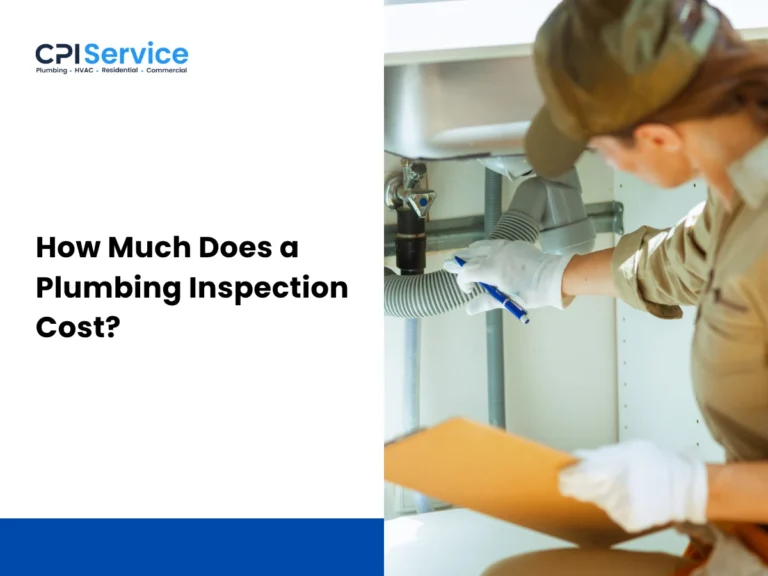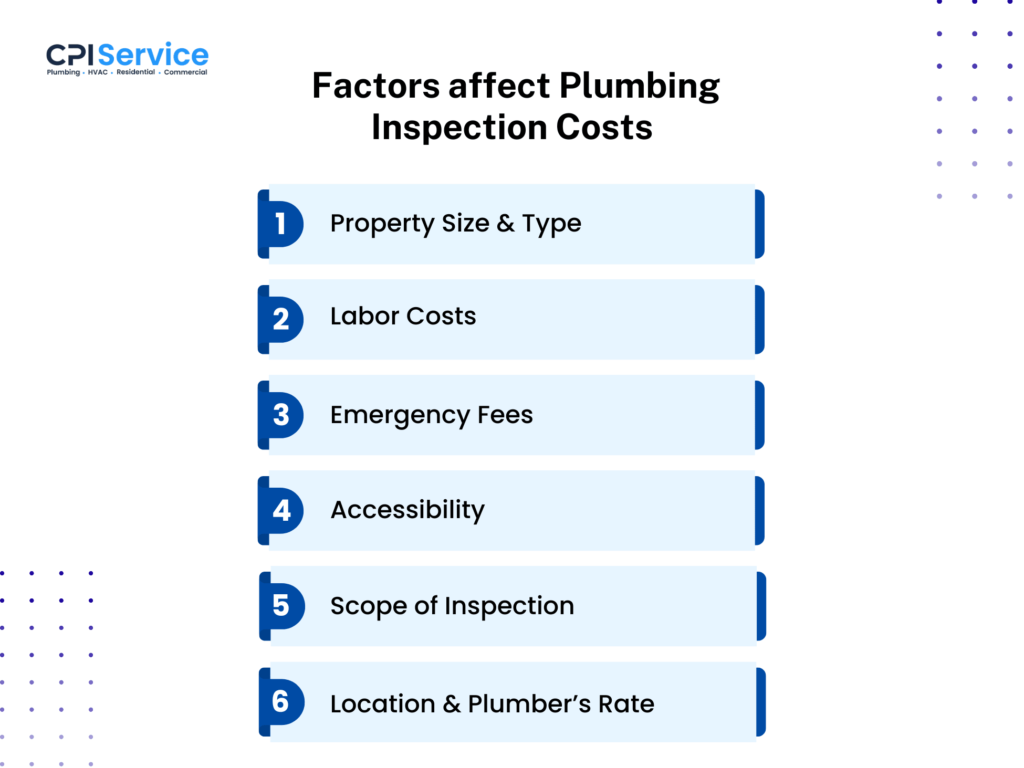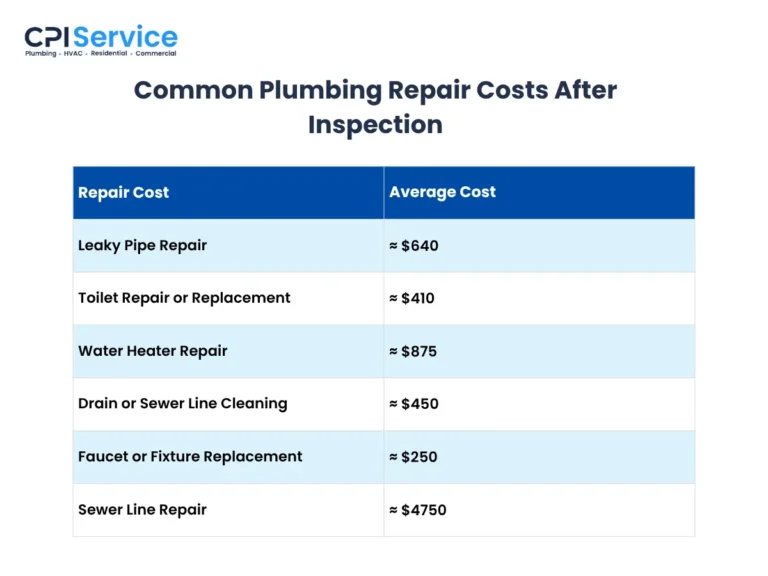How Much Does a Plumbing Inspection Cost?
A plumbing inspection typically costs between $150 and $400, depending on the home’s size, accessibility, plumbing complexity, inspection method, and labor rates. Basic visual checks are on the lower end, while inspections involving cameras or advanced equipment can reach $800 or more. For commercial or large residential systems, costs may exceed $1,000, especially when assessing sewer lines or hard-to-access areas.
In general, visual inspections are the most affordable, while comprehensive or camera-based inspections provide a more detailed assessment of both visible and hidden plumbing components. Following an inspection, homeowners may need additional repairs, depending on the findings, with costs varying by issue and materials used.
Plumbing inspections are also important for routine maintenance, property sales, and insurance. Knowing when to schedule one and hiring a licensed professional helps ensure accurate evaluations and prevents unexpected plumbing expenses. Homeowners should request a written quote that clearly outlines labor, inspection scope, and any diagnostic fees to plan their budget effectively.

What factors affect Plumbing Inspection Costs?
Plumbing inspection costs are influenced by the property’s size and age, local labor rates, inspection scope, location, and accessibility of the plumbing system. Larger homes or complex systems generally take more time to inspect, while difficult access or after-hours service can increase labor costs. The inspection method also plays a role, as camera or combination inspections are typically more expensive than standard visual checks. Understanding these factors helps homeowners estimate accurate pricing and compare quotes with confidence.

Property Size & Type
The larger and more complex the property, the higher the plumbing inspection cost. For example, a 1,200-square-foot apartment with a single bathroom may take under an hour to assess, while a 3,000-square-foot home with multiple bathrooms, a water heater, and connected HVAC systems requires more time and specialized tools. Multi-story or commercial buildings also demand detailed checks due to extensive piping and utility connections. In general, the property’s size and system complexity directly affect the inspection duration and total cost.
Labor Costs
Labor is often the single largest contributor to plumbing inspection cost. Rates vary depending on the plumber’s experience, certification level, and regional market conditions. Licensed and highly experienced plumbing inspectors typically charge higher hourly rates but provide more accurate assessments. For instance, hourly rates in larger areas like San Diego can be significantly higher than in smaller towns. Homeowners should inquire about hourly rates upfront to avoid surprises and obtain multiple quotes for comparison and better negotiation.
Emergency Fees
Emergency or after-hours plumbing inspections often cost more because they require immediate scheduling and extra labor expenses. These inspections are performed outside regular business hours, including weekends, nights, and holidays, when plumbers charge higher rates for availability and overtime work. Fees can add 50–100% to the base rate, but the higher cost often reflects the need to address urgent problems that could cause water damage or lead to costly repairs if not handled promptly.
Accessibility
The easier it is to access pipes and fixtures, the lower the inspection cost. Homes with plumbing located behind walls, under floors, or in crawl spaces require more time and specialized tools to inspect. Limited access increases labor hours and equipment needs, especially for older or remodeled properties that may require specialized inspection tools like inspection cameras, moisture meters, pressure gauges, pipe locators, and infrared sensors. The use of these advanced tools often raises the inspection cost since they require additional setup time, expertise, and can wear from repeated use.
Scope of Inspection
The scope of a plumbing inspection affects cost because broader evaluations require more time, tools, safety practices, and attention to detail. A basic inspection covers visible fixtures, faucets, and exposed pipes, while a comprehensive one includes internal lines that may leak or corrode, water heaters checked for efficiency and safety, and sewer systems inspected for blockages. Broader inspections take longer and use specialized equipment like cameras, increasing the overall price. While more expensive, a deeper inspection helps identify hidden issues and reduces the need for repeat visits.
Location & Plumber’s Rate
Geographic region and plumber expertise both affect inspection costs. Urban areas generally have higher service rates than sub-urban and rural areas due to higher demand and operating costs. In addition, certified plumbing inspectors who use advanced diagnostic tools like cameras, pressure gauges, and infrared sensors may charge premium rates. Checking multiple local quotes helps ensure fair pricing and allows homeowners to negotiate better. Regional differences, such as $100 per hour in NYC versus $50 in the midwest, can double total inspection costs.
Types of Plumbing Inspections
The most common types of plumbing inspections include visual inspection, camera inspection, and combination inspection. These vary in scope, tools used, and inspection depth. Choosing the right type depends on your plumbing system’s complexity and the purpose of inspection, which may be routine maintenance, property purchase, or problem diagnosis.

Visual Inspection
As the most affordable method, a visual plumbing inspection keeps costs low by focusing only on accessible fixtures, exposed pipes, drains, and water heaters, where inspectors look for visible leaks, corrosion, or pressure inconsistencies without using specialized tools. This non-invasive approach is ideal for routine maintenance or quick evaluations. However, it cannot detect hidden issues such as underground leaks or internal pipe damage, making it best for newer properties or surface-level assessments.
Camera Inspection
During a camera inspection, specialized cameras are used to examine pipes and sewer lines internally, which makes it more expensive than a visual check. The process involves inserting a flexible, waterproof camera into the plumbing system to identify blockages, cracks, corrosion, or tree root intrusions hidden from view. This method is especially valuable for diagnosing recurring clogs and slow drains. Though it costs more, it provides clear visual documentation that supports accurate diagnosis, targeted repairs, and reliable cost estimates.
Combination Inspection
As the most comprehensive option, a combination plumbing inspection carries the highest cost since it integrates both visual and camera methods. The process starts with a surface check of visible fixtures and exposed pipes, followed by internal camera diagnostics for concealed sewer lines. This dual approach identifies both external and hidden issues to ensure no part of the system is overlooked. While it costs more than standalone inspections, it delivers the most complete evaluation and helps prevent recurring plumbing problems and unexpected expenses later.
What is Included in a Plumbing Inspection?
A professional plumbing inspection includes a full check of your home’s fixtures, pipes, drainage system, shut-off valves, and water heater to ensure everything operates safely and efficiently. Inspectors assess both visible and hidden parts of the plumbing to detect leaks, corrosion, pressure problems, or safety concerns. The goal is to catch small issues early and ensure that every part of the system, from fixtures to main supply lines, is performing as intended.
Here is what a plumbing inspection typically includes:
- Fixtures and Faucets: Showers, bathtubs, and faucets are checked for leaks, pressure issues, and corrosion.
- Pipes and Fittings: Exposed pipes are inspected for visible damage, rust, or wear, while cameras are used for hidden pipes.
- Water Heater: Heating unit is evaluated for efficiency, leaks, and safe temperature control. Pressure relief valves and connections are also inspected.
- Drainage System: Drains, traps, and sewer lines are tested for proper flow and signs of clogs or blockages.
- Shut-Off Valves: Main and local valves are tested to ensure smooth operation and reliable water shutoff during an emergency.
- Appliances and Connections: Dishwashers, washing machines, and appliances are checked for tight hose connections and signs of leaks or water damage.
Common Plumbing Repair Costs After Inspection
After a plumbing inspection, homeowners may need repairs based on the issues identified. Repair costs vary widely depending on the problem’s severity, the materials used, and the required labor. Understanding average repair prices helps plan a maintenance budget effectively. Homeowners should request detailed estimates after inspections to better understand the costs involved and budget accordingly.
Below is a general cost breakdown for common plumbing repairs:
- Leaky Pipe Repair: $150–$400 for minor leaks, $500–$1,500 or even higher for major or concealed leaks.
- Toilet Repair or Replacement: $150–$300 for standard repairs, $400-$800 for full replacement.
- Water Heater Repair: $300–$500 for heating element or valve issues, $1,200+ for tank replacement.
- Drain or Sewer Line Cleaning: $100–$200 for minor clogs, $500–$1000 if using camera inspection or hydro-jetting for sewer line cleaning.
- Faucet or Fixture Replacement: $100–$400 including parts and labor for an average household.
- Sewer Line Repair: $1,000–$4,000 depending on damage extent and material type, with full replacement needing up to $10,000 in extreme cases.

When Should You Schedule a Plumbing Inspection?
A plumbing inspection should be scheduled every 1 to 2 years for most homes, or more frequently if the property is older or faces recurring plumbing issues. Regular inspections help detect leaks, corrosion, or buildup before they turn into major repairs. Homeowners should plan inspections based on home age, property events, and seasonal or environmental risks. Here are the key times to schedule a plumbing inspection:
- Recommended Inspection Frequency:Most homes need a plumbing inspection every one to two years. Older homes or those with a history of leaks, corrosion, or low water pressure may need annual inspections. Newer homes can typically go three to five years between inspections.
- Real Estate Triggers: Plumbing inspections are essential during property sales for both buyers and sellers. Buyers gain insight into the condition of pipes, drains, and water heaters before closing the purchase. Sellers, on the other hand, can fix hidden issues to avoid sale delays or value reduction. Having an inspection before finalizing the purchase provides confidence and helps prevent costly repairs later.
- Insurance Requirements: Many insurance companies require plumbing inspections before issuing or renewing homeowner’s policies, particularly for older properties. These inspections confirm that plumbing systems are up to code and not at risk for leaks or water damage. Keeping an updated inspection report can also speed up claim approvals.
- Seasonal and Tree Root Risks: Seasonal changes and nearby tree growth can put stress on plumbing systems. Freezing temperatures in December to February can crack pipes, while tree roots tend to invade sewer lines in spring and early summer. Scheduling an inspection in late fall or early spring helps identify these risks early and prevent costly emergency repairs.
DIY vs. Hiring a Professional Inspector
Homeowners can perform basic plumbing checks themselves, but professional inspections provide higher accuracy and long-term assurance. While a DIY inspection helps catch visible issues, hiring a professional ensures a complete system evaluation and reduces the likelihood of repeated or unexpected problems.
Here is how DIY and professional plumbing inspections compare:
Factors | DIY Inspection | Professional Inspection |
Cost | Free, aside from basic tools like wrenches or leak detectors. | Typically costs $150–$400, but may cost more depending on scope and property size. |
Accuracy | Detects visible issues like drips, leaks, or rust. | Uses cameras and gauges to identify hidden or underground problems. |
Equipment | Relies on basic observation and household tools. | Uses advanced diagnostic tools such as cameras, moisture meters, and pressure gauges. |
Safety | Limited safety awareness; risk when inspecting concealed systems. | Licensed plumbers follow safety standards and handle high-risk systems safely. |
Reliability | No official report; findings are based on personal observation. | Provides documented reports useful for insurance, maintenance, or property transactions. |
How to Hire a Plumbing Inspector?
To hire a plumbing inspector, verify their license, certifications, and experience to ensure they meet professional standards and understand local plumbing codes. A qualified inspector should be able to identify visible and hidden issues, provide a detailed evaluation report, and help prevent costly repairs later.
Follow these steps when choosing a plumbing inspector:
- Determine Type of Inspector Needed: Decide whether you need a residential, commercial, or specialised plumbing inspector, depending on your property type and system complexity.
- Check Licensing and Certification: Confirm the inspector holds a valid plumbing license and relevant certifications from recognized organizations.
- Verify Experience: Ask how long they have been inspecting residential or commercial plumbing systems and if they have worked with similar property types.
- Request References or Reviews: Look for customer feedback or professional references to gauge reliability and service quality.
- Compare Quotes: Obtain estimates from multiple licensed inspectors to understand pricing differences and included services.
- Ask About Inspection Scope: Ask which areas and systems are covered in their evaluation, such as water heaters, drains, and shut-off valves.
- Confirm Insurance Coverage: Verify the inspector carries liability insurance to protect both parties in case of accidental damage during the inspection.
Licensing and Certifications to Look For
Here is a list of key licences and certifications to check when hiring a plumbing inspector, with specific reference to California requirements.
- State-issued Licences: In California, anyone performing plumbing work valued at over $500 (including labour and materials) must hold a valid C-36 Plumbing Contractor License, issued by the California Contractors State License Board (CSLB).
- Specialist Inspector Certifications: Plumbing inspectors may also be certified by the International Association of Plumbing and Mechanical Officials (IAPMO), which qualifies them to conduct both residential and commercial plumbing inspections.
- National Professional Credentials: Outside of state-specific licences, look for certifications from the American Society of Home Inspectors (ASHI) or IAPMO’s national accreditation programme. Professionals earn these through rigorous training and examination, demonstrating advanced expertise.
- Training and Code Compliance: Ensure the inspector demonstrates familiarity with the California Plumbing Code and includes proof of compliance within their licensing or certification documentation.
- Credential Renewal and Validity: Confirm that all licences and certifications are active and in good standing, with no pending reviews or disciplinary actions.
By verifying these licences and certifications, you ensure that the plumbing inspector you hire is both legally authorised and professionally qualified to assess your system thoroughly.
Questions to Ask Before Hiring a Plumber
Before hiring a plumbing inspector, it is important to ask the right questions to ensure they are qualified, experienced, and reputable. Doing so helps verify their expertise and ensures the inspection will be both thorough and compliant with industry standards. Key questions to ask include:
- Are you a licensed and certified plumbing inspector?
- How many years of experience do you have in residential and commercial inspections?
- Have you inspected a home like mine before?
- Do you carry liability insurance and worker protection coverage?
- What types of plumbing systems do you specialize in?
- What tools or methods do you use during inspections?
- Can you provide a sample inspection report or references from past clients?
- What does your standard inspection include, and are there any additional costs?
Asking these questions helps homeowners identify a capable and trustworthy inspector who can deliver a detailed, unbiased evaluation. This careful vetting process ensures a thorough inspection, reduces the likelihood of overlooked issues, and supports long-term reliability of the plumbing system.
Asking these questions helps homeowners identify a capable and trustworthy inspector who can deliver a detailed, unbiased evaluation. For expert, certified plumbing service, homeowners can rely on licensed technicians to inspect their homes and provide optimal solutions.
Frequently Asked Questions
How long does a plumbing inspection take?
A plumbing inspection usually takes between 1 and 2 hours, depending on the home’s size and the complexity of the plumbing system. The duration can vary based on the number of fixtures, the type of plumbing (modern or older systems), and whether advanced tools such as cameras are used to inspect hidden pipes.
Is a plumbing inspection worth it before buying a house?
Yes, a plumbing inspection is absolutely worth it before purchasing a home. It helps uncover hidden issues that may not appear during a standard home inspection, such as leaks, outdated materials, or potential sewer line problems. Identifying these issues in advance can prevent unexpected expenses after closing and provide negotiation leverage during the buying process.
Can I get a free plumbing inspection?
Yes, some plumbing companies provide free plumbing inspections, but these are limited to simple visual checks and do not cover the entire plumbing system. Such inspections are often promotional offers or linked to repair or maintenance services. They are useful for spotting surface-level issues like leaky faucets or visible corrosion, but they rarely include detailed assessments of underground pipes, sewer lines, or internal plumbing. For homeowners seeking a complete and accurate evaluation, it is best to hire a licensed professional.

Alex Hamilton
Alex Hamilton is the owner of CPI Service, a trusted provider of plumbing and HVAC solutions. With over 35+ years of hands-on experience in the industry, He brings deep technical expertise and a proven track record in delivering reliable installation, maintenance, and repair services. His leadership ensures that CPI Service consistently upholds the highest standards of quality, safety, and customer satisfaction.
